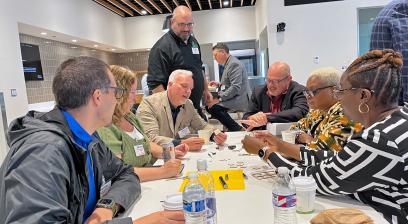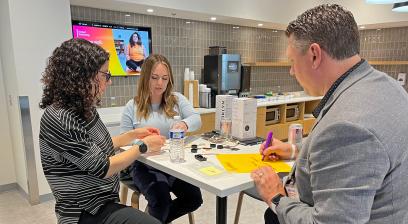A handful of teachers gather around a table scattered with what looks like the aftermath of child’s birthday party: a pair of stick-on googly eyes, some zip ties, pre-cut pieces of balsa wood that could possibly come together as an airplane, two sets of dime-sized wheels, and electrical circuits that are most likely a battery. Instructions are notably absent. Their task? Put it together. Whatever ‘it’ is. In less than 10 minutes.
“This is how we get kids interested in STEM,” says Robert Simmons, director of Micron Gives North America at Micron Technology. “Tinkering. This is the entry point. Kids don’t know what a microchip is, but they know how to tinker. My first journey in STEM was taking apart my uncle’s turntable. It didn’t start with theory. It started with hands-on tinkering.”
Simmons is leading the session of about 30 New York-based middle and high school educators (all AFT members) as part of a two-day professional development immersion at Micron Technology’s campus in Manassas, Va. The educators are helping pilot an Advanced Technology Framework in 10 New York school districts beginning this fall. When fully implemented, 10th-, 11th- and 12th-graders will have access to job exploration and foundational and technical skills to enter the microchip industry. The pilot is a result of a groundbreaking partnership among the AFT, the United Federation of Teachers (UFT), New York State United Teachers (NYSUT), Micron and New York Gov. Kathy Hochul.
The experience also included a visit to the nanofabrication facility at George Mason University’s science and technology campus, where the educators met instructors and saw the facilities that serve as a preparation pipeline for Micron careers. AFT members then had an opportunity to hear from a panel of local school district career and technical education directors about their partnerships with Micron to expose all students—and especially to recruit and support low-income and traditionally underrepresented STEM students—to the high-tech career pathways offered by Micron.
“There are no Micron employees—or employees in the semiconductor industry—without K-12 education,” Simmons told the AFT’s American Educator. “There’s a reason that Micron has a team of people working with K-12 educators and that most of the people on that team come from K-12. We need to partner with those who are closest to communities and closest to kids: the teachers. We see [the Advanced Technology Framework] as a continuation of our effort to ensure young people have a pipeline not just to a job but to a dream.”
Micron Technology plans to build the nation’s largest semiconductor fabrication facility—seven times larger than the nearly 200,000-square-foot, $375 million facility in Manassas—in central New York over the next twenty-plus years. The facility will provide 9,000 jobs, half of which will require technical skills and education. The Advanced Technology Framework is designed to introduce students to advanced manufacturing and semiconductors and prepare them for an array of career paths the facility will provide.
“This is going to bring almost 10,000 jobs to a small town,” says Leo Gordon, vice president of CTE for the UFT. “If we invest the time right now to build out the correct programming, by the time the plant is done, we will have students ready to get into the industry.”
The need: more than 10,000 jobs
The Advanced Technology Framework is currently in 10 school districts and BOCES (Boards of Cooperative Educational Services). After the initial three-year pilot phase, the goal is to scale up and sustain the program across New York state to increase the pipeline of students interested in the semiconductor industry and to expand workforce development.
“We have multiple manufacturers out there looking for skilled workers,” says Gordon. “There is a disconnect between the school system and the industry right now, but there are more than enough jobs that lead to great careers if we strategize how we train and place our young people.”
The demand for skilled workers in the manufacturing sector is set to steadily increase in the United States, a result of President Joe Biden’s 2022 CHIPS and Science Act, which increases domestic investment in high-tech research and semiconductor manufacturing.
“This program is about meeting industry needs,” says Gordon. “Advanced manufacturing is growing.”
The Advanced Technology Framework also strikes a blow to any stigma associated with students in CTE, says Israel Rodriguez, a teacher at Brooklyn STEAM Center, one of the schools in the pilot program: “New York City, for decades, has had this stigma between academics and CTE, and having that value now being a point of focus on CTE, particularly from a company like Micron, really opens up the mindset of students,” he says. “And having opportunities, like being able to tour a facility like this, can turn them on to a pathway that they’ve never thought of before. It shows them that they can actually go anywhere.”
The opportunity in ‘tinkering’
A wall of frosted glass stands next to the tables where the educators are diligently working together to solve the mystery of what exactly the googly eyes have to do with the balsa wood and the sets of wheels. At the press of a button, the frost on the glass fades, and the educators are looking into Micron’s nearly 100-percent automated manufacturing floor. The size alone is impressive, but the science and skill make it even more so.
To Rodriguez, it all looks familiar. He is in his third year teaching at Brooklyn STEAM after “tinkering” in high school CTE classes led him to a career in manufacturing.
“I was on a robotics team in high school,” he says. “I learned all my machining skills there. And I think if it wasn’t for that, I wouldn’t have been a good enough engineer later on in my career to be able to read blueprints, create my own models, and go into the machine shop and say, ‘Hey, are you using this machine right here? No? I'm going to use it. I’m going to start building my prototype.’”
For Emama Akhter, a cybersecurity teacher at Brooklyn STEAM, tinkering in CTE classes led to a career in tech, which led to computer networking, which led to an “aha moment.”
“I used to hate computer networking in high school because I never understood how it was applicable. It’s such a theoretical concept. But when I worked up to networking in my career, I realized it was fun. As soon as I started doing it, it made sense. So now when I teach it, I show my students that this is actually real. I give them a problem and ask them to figure it out.”
The project-based problem-solving is where she sees aha moments for her students as well.
“When they do projects, that’s when they say, ‘Oh, that’s what you were teaching about last week with encryption methods.’ Or we’ll do an easy baseline project together, and then I’ll give it to them again, but with a more difficult step. We’ll walk through what they did and what they observed, and what conclusions they can draw. That’s when I start to see the ‘ahas,’” she says.
Entering the teaching profession was its own aha moment for both Akhter and Rodriguez.
“I was in manufacturing until I realized I was the only minority engineer in the facility,” Rodriguez says. “Every facility I went to, I was always the only Latino engineer.”
Teaching at Brooklyn STEAM, which has a majority Latinx student population, is another way of showing his students what is possible. Akhter agrees: “There aren’t many people of color in cybersecurity or people who look like me in STEM.”
Opportunity beyond careers
The teachers are concentrated in one small area of high-ceilinged, brightly lit, stark-white anteroom. The room leads to the manufacturing floor, and everyone has to stay inside the designated area to avoid contaminating anything. The slightest particle can ruin the silicon wafers on the other side of the door.
Ryan Schoenberg, the technician guiding this portion of the tour, is also a product of CTE.
“I struggled in high school. I tried community college, and that didn’t go all that well either—until I discovered that if I had a wrench in my hand, I liked what I was doing. I was doing well. And all of a sudden, I had a career.”
The Advanced Technology Framework will open up that manufacturing floor to students like Schoenberg who never may have known it was an option. But no matter where they end up, the value of CTE will stay with them, says Sarah Loudon, a robotics teacher at Watertown High School.
“I have some students who will be the first generation to attend college, and they’re trying to go that route and take care of their family,” she says. “I have some who work part time at fast-food restaurants and they want to go that route, but just want some hands-on learning experiences. And I have some students who go on to really high-level universities. But no matter where they go, the exposure to robotics, to manufacturing, to science, to problem-solving—it will benefit them.”
[Melanie Boyer]


